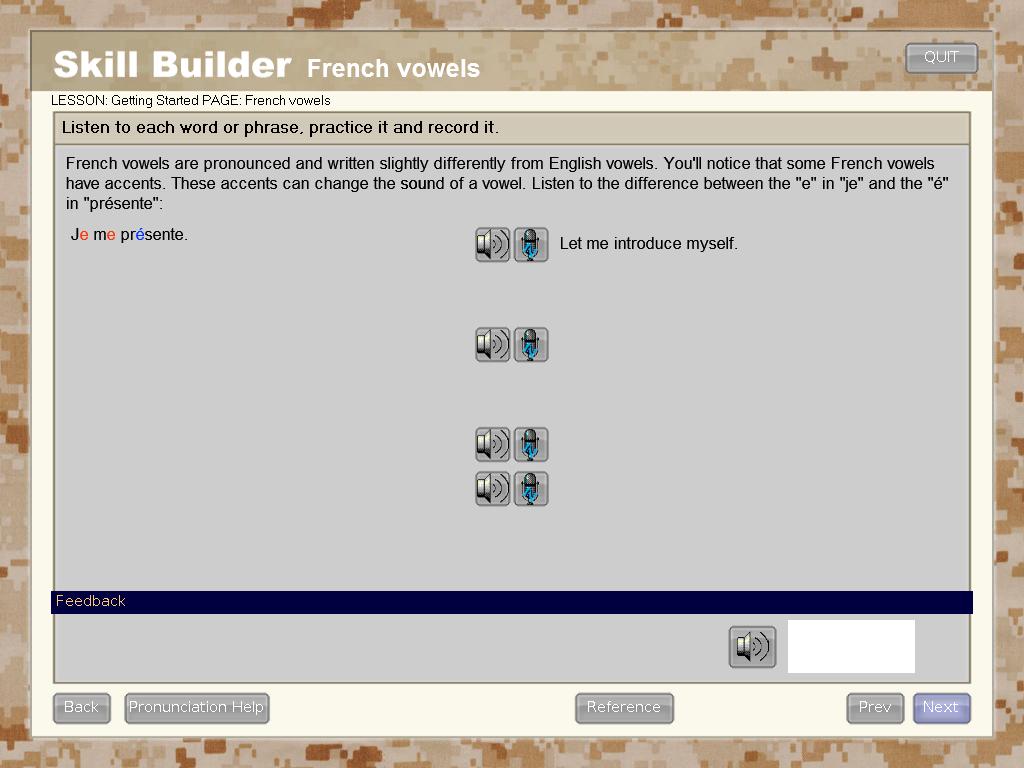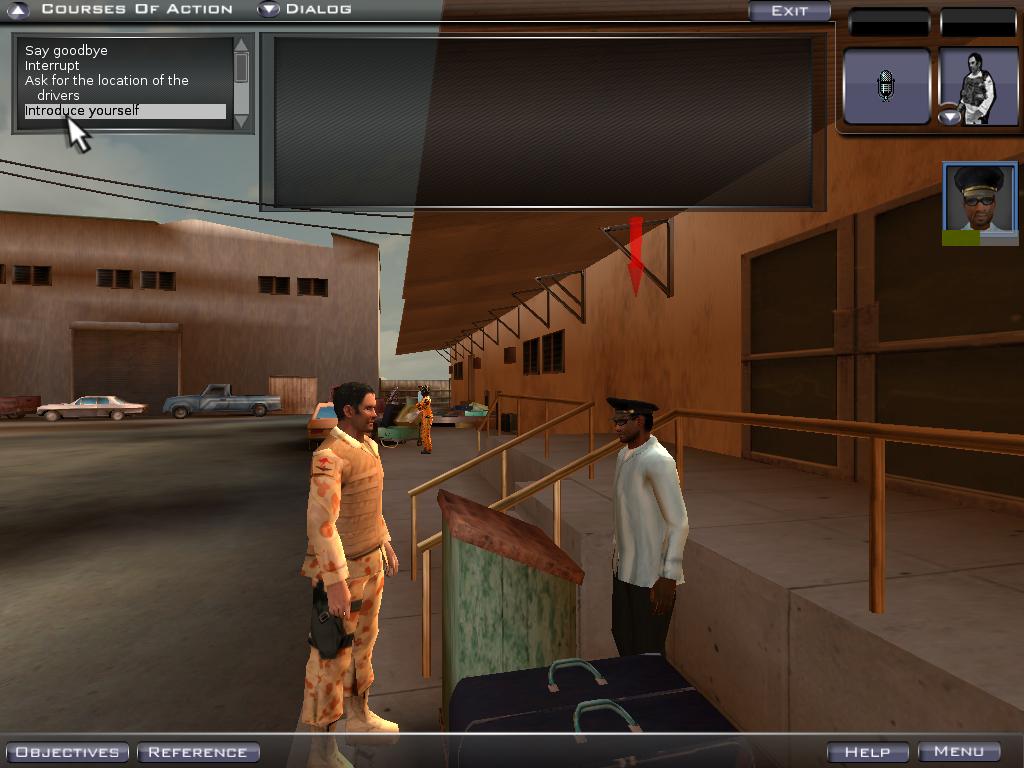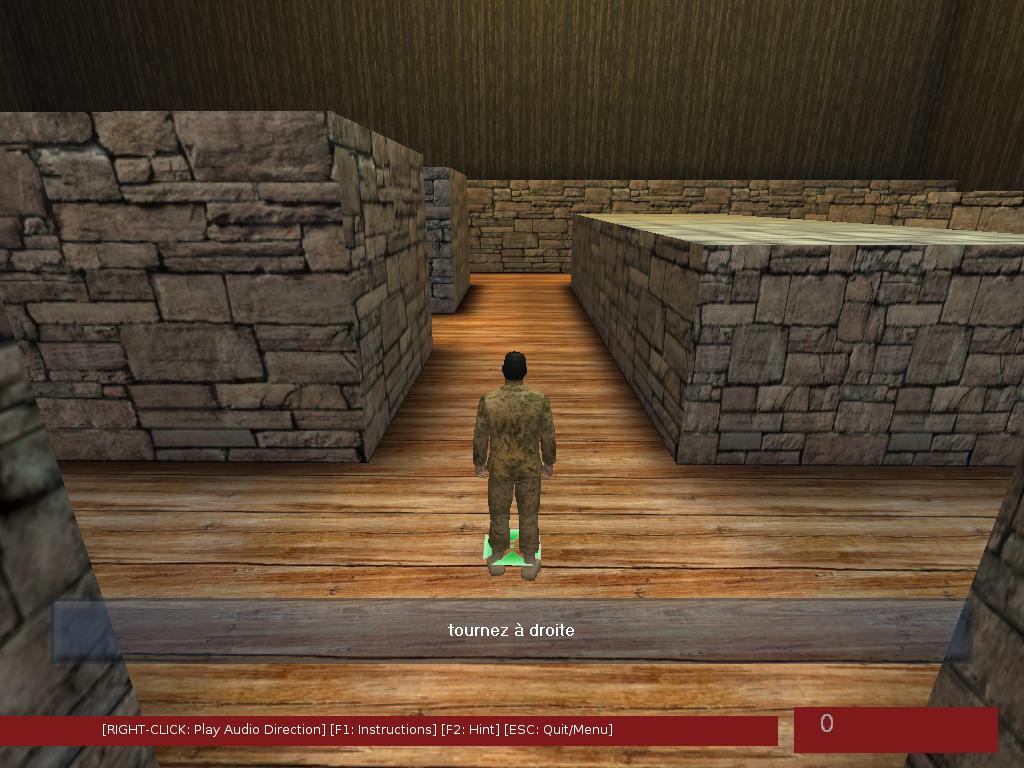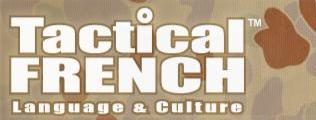Introduction
Tactical French is an educational game that uses avatars viewed from a third person perspective to teach and reinforce the French language and social protocol within the countries of Sahel Africa You play as a soldier sent to Africa to help train soldiers in the armies and to better relations between your and the African countries.
Below is a detailed analysis of this game roughly following Brian Winn's1 Design/Play/Experience framework, including:
Learning
The primary learning goal of Tactical French is for soldiers being posted in French-speaking countries in Africa to have a working knowledge of French. The game teaches all levels of French starting from basic grammar, vocabulary, and punctuation to learning how to give orders to or train soldiers in French. It does this by having the player see and listen to the phrase in French with its translation in English. The game uses voice recognition software to help aid in the learning of the language. After they introduce every phrase or vocabulary term, they have a short speaking test which shows you the word in English and has you speak the phrase in French. Specifically, it teaches the players every step in getting into the country and doing their job and the vocabulary/phrases needed. Not only does it teach you how to speak French but it also goes through proper etiquette and social norms within the country including gestures considered polite or social taboos. In the end, people that play this game should be able to work for the military in French-speaking African countries.
Storytelling
For the setting of Tactical French, you are a soldier sent to the French-speaking countries of Sahel Africa. The game is split up into several different scenarios with separate objectives, the first of which has you walk around after getting through security to find your luggage and to find a driver to drive you to your destination. Actual storytelling in game isn’t done in a traditional sense with text on screen as much with the exception of a short briefing before starting each scenario. In-game, a large list of applicable phrases is put up and you get to choose which phrase you want to say into the microphone. Overall though, the game is very light on story elements. It gives you a back story and objectives which point you in the correct direction but otherwise you’re free to do whatever you want with no real narrative.
Gameplay
Tactical French consists of three different game modes, each of which uses voice recognition to play. The first game mode is the Skill Building mode. In this mode you learn the vocabulary, phrases, gestures, and social norms and practice them as much as needed with quizes to help reinforce the information. In this game mode there are three steps for every level of training there is.

- The player is taught the phrase and/or vocabulary in French next to its English translation along with the phonetic pronunciation of the word and a button that plays an audio sample.
- The player is then quized on the phrase by being given the english definition and being asked to record the phrase in French into a microphone.
- Finally, once all phrases and vocabulary are learned, the player is tested within a simple conversation with a simple story for context. The player is scored based on how appropriately they responded to the other person. Calling an older woman Mademoiselle or a younger woman Madame would get you less points than if you had used the correct term.
Once the player has gone through enough of the Skill Building mode, they can then move on to the Mission mode. In this mode the player takes control through a third-person perspective of a character and is given several objectives. Their objectives have them walk around talking with people to complete the objectives. Once the player initiates conversation with an NPC they can choose a phrase to say into the microphone out of a large list. Depending on what they say, the trust meter underneath every NPC's portrait may rise or fall. This is usually brought about by an impolite response or a breach of social protocol such as not showing the proper gesture when greeting someone for the first time.

Finally, there is the Arcade mode which is a series of minigames used to reinforce vocabulary used everyday. One of them for example puts the player in control of a soldier in a pacman-like game where the player must move the soldier by saying commands in French. The player is scored based on how many objectives they reached with points being deducted for wrong answers.

User Experience
The user interface is roughly like an MMORPG environment where you are viewing your avatar in a 3rd person frame of reference. There are menus for interacting with the NPCs, both for deciding what you want to say in English and then for deciding how you think it should be said in French. There is a button for activating the microphone for inputs. Movement is done using the arrow keys. For the most part, this method seemed to work very well, though the microphone versus choosing dialogue options was very confusing. It did interfere with learning some in the early stages, since there was some ambiguity as to whether I had to answer using the choices or the microphone.
Technology
This game runs on a computer running a Windows based operating system and can be used using a microphone. Having the microphone greatly aids learning, since it can help with pronunciation but it also means that the program must be up to handling the requirements of spoken language processing. The only real choice I would have made differently would be to make the game available on more operating systems since having it be Windows only limits the player base.
Assessment
A brief search of the Internet reveals several informal studies done which show that Tactical Language software is more effective than traditional classroom learning. It is praised for its use of the spoken medium both in that the player hear the language spoken constantly and that they are speaking it. For a more formal assessment, I would recommend comparing it to Rosetta Stone, rather than traditional book and classroom learning, since Rosetta Stone is also a video game.
Conclusion
In conclusion, Tactical French is an extremely useful game specifically for those in the armed services that need to learn French. It may not make you a linguistic expert in French but it will certainly give you enough knowledge of the language to work with. Areas that could improve would definitely be in making the voice recognition work better. Trying to learn and speak with the French accent can sometimes cause problems. Tactical French and its other versions, Tactical Iraqi, and Tactical Pashto are already being used with the military's DARWARS program to help accelerate troop deployment.
